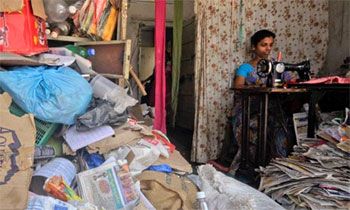Only 4 per cent of 57.7 million small business units in India have access to institutional finance, leaving many to rely on informal lenders
 A new bank announced in the annual Budget last week could boost loans and cut borrowing costs for the country's cash-starved small businesses - tailors, mechanics and phone booth operators who account for around a fifth of the economy.
A new bank announced in the annual Budget last week could boost loans and cut borrowing costs for the country's cash-starved small businesses - tailors, mechanics and phone booth operators who account for around a fifth of the economy.
MUDRA bank - to be set up with $3.2 billion of capital to help microfinancing firms to lend more - should help leverage up firms which account for 40 per cent of India's exports, just as India tries to rekindle growth, lenders and entrepreneurs say.
India's small businesses employ more than 106 million workers, according to government statistics, in a country that brings a million new workers into the workforce every month.
Yet according to government estimates, only 4 per cent of 57.7 million small business units in India have access to institutional finance, leaving many to rely on informal lenders. Industry experts estimate that demand for loans from the sector outstrips supply by more than $80 billion.
There is little information available yet on the terms of refinancing and loan rates, and who MUDRA may be able to help. The creation of the new bank has made executives in microfinance and non-bank finance companies optimistic, however, that the funds to be made available through MUDRA will increase liquidity and so lower their borrowing costs and in turn the burden on borrowers.
Microfinance and non-bank financing companies currently charge interest rates of more than 20 percent, more than twice banks’ base rate, which they attribute to high cost of funds.
"The big question mark was who would finance these institutions who lend to this segment," said Anurag Agrawal, chief executive at Intellecap, which has non-banking finance units and is looking to enter small business lending.
Rating agency Crisil estimates that microfinance lenders have loan assets totalling $5.6 billion. But they have had a limited impact on small businesses as they primarily target lending to individuals or groups of individuals among the poor.
Even for the microfinance institutions that would like to lend more to businesses, rules cap the amount they can lend to a single borrower at Rs 50,000 ($803), making them an unviable option for many businesses.
"The micro and small enterprises have been starved of credit," said Alok Prasad, chief executive of Microfinance Institutions Network (MFIN), a regulatory body for the sector.
Loans between Rs 50,000 and a million rupees from formal lenders are "almost completely unavailable", Prasad said.
Mumbai entrepreneur Vipul Vora chased more than a dozen banks for two-and-a-half years before a lender agreed to give him a 10-million-rupee ($161,708) loan to set up a plant to produce jaggery, a traditional sweetener, in western India.
"It is absolutely difficult," said Vora, 55, who is starting a new business after closing down an earlier venture five years ago. "I must have printed about 25,000 pages (of paperwork)... Some banks asked for eight times that amount as collateral."
Small businesses say mainstream banks often ask them for excessive collateral.
Banks, particularly dominant state lenders who are already under pressure over bad loans, have largely held back from lending to a sector where debt repayment installments can often be less than the cost of pursuing the payment.
Additional reporting by Shailaja Sharma









